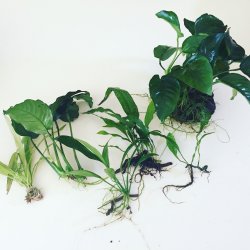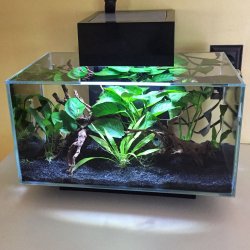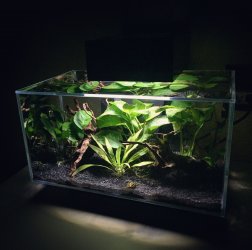thrujenseyes
Fish Herder
Our plant chat made me feel like it was time to get in there and propagate some things.
Oh and I wanted to tell Byron that I had reduced my light time by a few hours a day and it's helped a lot with the black anubias leaves!
Also I cut it back some and it's no longer touching the top.
Sad news though....I lost one of my endlers during this plant session and I have no idea how.
When I was all done and admiring my work only one endler was eyeballing me from inside...
I looked everywhere. Gave it some time thinking that maybe it was still hiding because I had really just went thru there like a tornado ...but nope. Days later and still MIA
I'm hoping to god he wasn't in my bucket of siphoned water that I poured over the plants outside.
I check the bucket good because I had sucked them up a time or two before.
But this bucket did have plants in it since I was moving things around.
I looked thru all of my plants outside (needle in a hay stack).
Poor guy...SIP little man.



Oh and I wanted to tell Byron that I had reduced my light time by a few hours a day and it's helped a lot with the black anubias leaves!
Also I cut it back some and it's no longer touching the top.
Sad news though....I lost one of my endlers during this plant session and I have no idea how.
When I was all done and admiring my work only one endler was eyeballing me from inside...
I looked everywhere. Gave it some time thinking that maybe it was still hiding because I had really just went thru there like a tornado ...but nope. Days later and still MIA
I'm hoping to god he wasn't in my bucket of siphoned water that I poured over the plants outside.
I check the bucket good because I had sucked them up a time or two before.
But this bucket did have plants in it since I was moving things around.
I looked thru all of my plants outside (needle in a hay stack).
Poor guy...SIP little man.






 for fishies
for fishies  ) as a result of the plants taking up some and the denitrifiers the rest. But for most, nitrate will be resulting at hopefully low levels. But this is then added to the initial nitrate, raising the level higher, and that is where it can become problematic. In many cases one can increase the volume or frequency of water changers to keep nitrates low if they tend to occur higher, but when they are already in the source water that process loses most of its effectiveness.
) as a result of the plants taking up some and the denitrifiers the rest. But for most, nitrate will be resulting at hopefully low levels. But this is then added to the initial nitrate, raising the level higher, and that is where it can become problematic. In many cases one can increase the volume or frequency of water changers to keep nitrates low if they tend to occur higher, but when they are already in the source water that process loses most of its effectiveness.